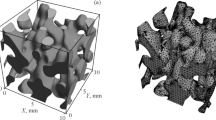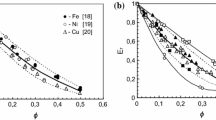The work is dedicated to formulating a new behavioral model of porous and powder bodies and aims to consider the internal structure features of the new material classes. Analysis of existing models shows that most of them rely on the hypothesis that the only parameter of the material is porosity. In the meantime, numerous structure observations of these materials indicate a significant impact of other types of imperfections on the properties, which may include crack-like defects. During deformation, they can facilitate the emergence of overconsolidation cracks with the subsequent destruction of a product even at its manufacturing. Furthermore, such models are not sensitive to resistance in compression and tension. They also disregard the change in volume in the absence of hydrostatic pressure. To address these gaps, a new four-parameter plasticity theory is proposed. It describes the behaviour of powders and porous semi-finished products that include two new parameters in addition to porosity and mean deformation of the solid phase in the porous body. They reflect the influence of resistance and the presence of dilatancy. Taking these into account, the expression for the dissipative potential and the load surface of such four-parametric material is formulated. The major difference between the proposed and existing models is that it describes a material, which can be both bulk and porous. The tensile yield point of the bulk material is considered to be zero. On the contrary, the yield strength in tension and compression of porous materials are equal to each other under conditions of perfect contact and full adhesion. The physical meaning of two new material parameters was clarified. Their influence on the development of overconsolidation cracks in the conditions under which complex products are manufactured is established. The reasonableness of using the proposed model for the 3D printing process is outlined.















Similar content being viewed by others
References
M.Yu. Bal’shin, Scientific Bases of Powder Metallurgy and Fiber Metallurgy [in Russian], Metallurgiya, Moscow (1972), 336 pp.
Yu.G. Dorofeev, Dynamic Hot Pressing of Porous Billets [in Russian], Metallurgiya, Moscow (1977), 216 pp.
V.V. Skorokhod, Rheological Theory of Sintering [in Russian], Nauk. Dumka, Kiev (1972), 152 pp.
G.M. Zhdanovich, Theory of Pressing of Metallic Powders [in Russian], Moscow (1969), 260 pp.
M.S. Koval’chenko, Theoretical Bases of Hot Treatment of Porous Materials under Pressure [in Russian], Nauk. Dumka, Kiev (1980), 238 pp.
V.E. Perelman, Forming of Powder Materials [in Russian], Metallurgiya, Moscow (1979), 232 pp.
G.L. Petrosyan, “On the theory of plasticity of porous bodies,” Izvestiya Vysshikh Uchebnykh Zavedenii. Ser. Machinostroenie, No. 5, 10–14 (1977).
I.F. Martynova and M.B. Stern, “Plasticity equation for porous bodies, taking into account the true deformations of base metal,” Powder Metall., No. 1, 23–29 (1978).
V.V. Skorokhod and L.I. Tuchinsky, “To the question of energy consumption for compaction of porous bodies,” Powder Metall., No. 9, 16–21 (1978).
A.M. Laptev, “Criteria of plasticity of porous metals,” Powder Metall., No. 7, 12–18 (1982).
V.Z. Midukov and V.D. Rud, “Experimental verification of plasticity hypotheses of porous bodies,” Powder Metall., No. 1, 6–17 (1982).
O.V. Mikhailov and M.B. Shtern, “Consideration of different resistance to tension and compression in theories of plasticity for porous bodies,” Powd. Metall., 5, 11–17 (1984).
O. Cobe and P. Brewin, “Modeling and numerical simulation of powder compaction,” Powd. Metall., 45, No. 1, 18–19 (2002).
J. Kergadallan, G. Puente, P. Doremus, and E. Pavier, Proc. Int. Workshop on “Modelling of metal powder forming processes” (Grenoble, France, 21–23 July), p. 277–285 (1997).
P. Doremus, M. Shtern, P. Brewin, A. Cocks, D. Guyoncourt, J. Tweed, M. Riera, and J. Prado, “Material data base for simulating die compaction,” in: Proceedings of International Congress of Powder Metallurgy (Vienna, Austria, 17–21 October), 5, 17–23 (2004).
L.C.R. Schneider and A.C.F. Cocks, “Experimental investigation of yield behavior of metal powder compacts,” Powder Metall., 45, No. 3, 237–245 (2002).
S. Shima, H. Kotera, and P. Mosbah, “A study of mechanical behavior of iron powders by threedimensional compaction,” in: Proceedings of International Workshop on “Modelling of metal powder forming processes” (Grenoble, France, 21_23 July), 9–17 (1997).
E. Pavier and P. Doremus, “Triaxial characterisation of iron powder,” Powder Metall., 42, No. 4, 345–352 (1999).
O. Lame, D. Bellet, M.D. Michiel, and D. Bouvard, “Bulk observation of metal powder sintering by X-ray synchrotron microtomography,” Acta Materialia, 52, Issue 4, 977–984 (2004).
E. Korosteleva, V. Korzhova, and M. Krinitcyn, “Sintering behavior and microstructure of TiC–Me composite powder prepared by SHS,” Metals, 7, Issue 8, 290–300 (2017).
G. Ziegler, Extreme Principles of Thermodynamics of Irreversible Processes and Continuum Mechanics [in Russian], Mir, Moscow (1966), 136 p.
A. L Gurson, “Continuum theory for ductile rupture by void nucleation and growth: Part 1. Yield criteria and flow rules for porous media,” J. Eng. Mater. Technol., 99, 2–15 (1977).
M.B. Shtern, “Definitive equations for plastic porous bodies,” Powder Metall., 4, 17–23 (1981).
M. Shtern “On the constitutive potential for powder and porous bodies, mechanics of granular and porous materials,” in: Proc. of the IUTAM Symposium (Cambridge, U.K., 15-17 July, 1996), N.A. Fleck, A.C.F. Cocks (Eds.), Kluwer Academic Publishers, Dordrecht; Boston; London (1997), p. 95–105.
M. Shtern, A.C.F. Cocks, The Structure of Constitutive Laws for the Compaction of Metal Powders, Recent Developments in Computer Modeling of Powder Metallurgy Processes, IOS Press (2001), p. 71–81.
M.B. Stern and V.D. Rud, Mechanical and computer models of granular media consolidation [in Ukrainian], Ed.-Publ. Department of Lutsk National Technical University, Kyiv–Lutsk (2010), 232 pp.
D. Bigoni and A. Piccolroaz, “A new yield function for geomaterials,” in: Constitutive Modelling and Analysis of Boundary Value Problems in Geotechnical Engineering (Napoli, April 22–24, Hevelius), Hevelius (2003), p. 265–281.
K.H. Roscoe, A.N. Schofield, and C.P. Wroth, “On the yielding of soils,” Géotechnique, 8, Issue 1, 22–53 (1958).
A.N. Schofield and C.P. Wroth, Critical State Solid Mechanics, McGraw-Hill, London (1968), 218 pp.
D.C. Drucker and W. Prager “Soil mechanics and plastic analysis or limit design,” Q. Appl. Math., 10, 157–165 (1952).
P.R. Brewin, O. Coube, P. Dorémus, and J.H. Tweed, Modelling of Powder Die Compaction, Springer-Verlag London Limited (2008), 329 pp.
O. Coube and H. Riedel, “Numerical simulation of metal powder die compaction with special consideration of cracking,” Powder Metall., 43, 123–131 (2000).
F.L. DiMaggio and I.S. Sandler, “Material model for granular soils,” J. Eng. Mech. Div., 97, Issue 3, 935–950 (1971).
M.B. Shtern and O.V. Mikhailov, “Modified models of deformation of powder materials based on plastic and hard-to-deform powders,” News of National Technical University of Ukraine “Kyiv Polytechnic Institute." Ser. Mechan. Engineer., 62, 13–19 (2011).
M.B. Shtern, “Development of the theory of powder pressing and mechanics of deformation of porous bodies,” Powder Metall., 9, 15–29 (1992).
O. Zenkevich, Finite element method in Engineering [in Russian], Mir, Moscow (1975), 541 pp.
Author information
Authors and Affiliations
Corresponding author
Additional information
Translated from Poroshkova Metallurgiya, Vol. 60, Nos. 1–2 (537), pp. 27–44, 2021.
Rights and permissions
About this article
Cite this article
Shtern, M., Mikhailov, O. & Mikhailov, A. Generalized Continuum Model of Plasticity of Powder and Porous Materials. Powder Metall Met Ceram 60, 20–34 (2021). https://doi.org/10.1007/s11106-021-00211-7
Received:
Published:
Issue Date:
DOI: https://doi.org/10.1007/s11106-021-00211-7




